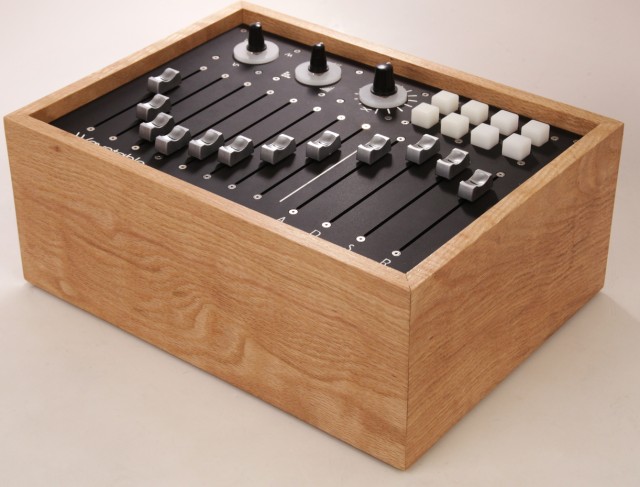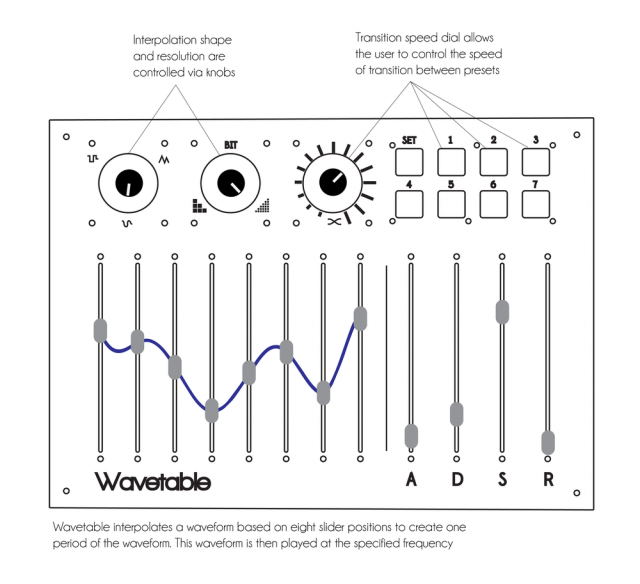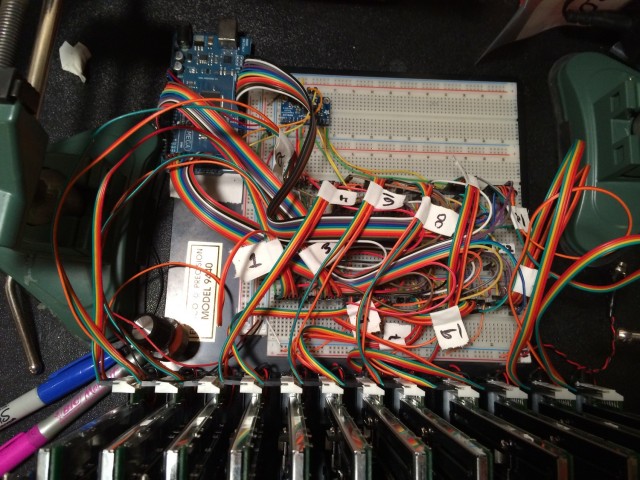
Reader Seth Kranzler is a student in an experimental New Media graduate program at NYU. He let us know about his Wavetable Synthesizer, above, a synth that explores what he calls ‘creative synthesis’.
Here’s a video demo:
Here’s what he has to say about the Wavetable Synthesizer:
The Wavetable Synthesizer utilizes what I have dubbed “creative synthesis”.
Instead of indirectly affecting waveform shape with envelopes, LFO’s, and oscillators, the Wavetable Synthesizer allows the user to directly control the waveform shape using 12 sliders and two knobs
Eight of the sliders control the overall shape of the wave (acting much like “attractors” on a line), while two knobs control how the points are interpolated (smooth, triangular, or square) and at what resolution (from fine to coarse).

The four sliders labelled “A”, “D”, “S”, and “R” are used for attack, decay, sustain, and release respectively. Users can access saved waveforms with a bank of buttons, and when selected, can watch the controller transform automatically to these settings. The rightmost knob allows for control of the transition speed between presets.

Under the hood, the brains of the controller is an Arduino Mega 2560. Details on the construction are available at Kranzler’s site.
Check it out and let us know what you think of the idea of using motorized faders on hardware synths – and Kranzler’s approach to tactile waveshape control.

The general idea of creating waveforms with sliders is quite naive. With only 8 sliders the waveform is sampled at 8 points, which does not allow to control overtones higher than 4th harmonic (Shannon sampling theorem). All in all, the range of timbres obtainable in this way is extremely limited, considering the number of controls involved.
you missed the interpolation knob… noob
Interpolation is nothing more than just filtering. A filter does not create new harmonics, it just makes the sound more or less dull.
I think you’ve misunderstood a lot of things here, starting with Shannon’s theorem (more widely known as Nyquist theorem, actually Nyquist-Shannon to be precise) and following with how overtones determine the shape of a wave. As for the first one, it’s about the sampling frequency, which has nothing to do with how many sliders you use to visually approximate a waveform whose actual frequency changes with every note. If the machine ran at an 8 hz sampling frequency like you seem to think, it would be inaudible.. As for the second point, a square wave can be accomplished with just two sliders (not eight!) and no interpolation in between (there’s a knob for that here), but it’s actually the result of adding up an infinite series of odd harmonics (at least a perfect square wave).
Or maybe I just did not understand a word you said, always a possibility. 🙂
As for the actual sound, rich or not, pleasant or not… no real opinion but I’m not too impressed by this demo. I’m sure you can do lots more with it, though, pity we don’t get to see more.
You are quite correct in regards to the theorem. I do not think you misunderstood the other person at all. They just didn’t get it.
You are confusing fundamental things. I never said the sampling rate was 8Hz. It is 8 points PER CYCLE (not per second!!!), which means it is 8 times the fundamental frequency of the waveform. Regardless of whatever interpolation you use (constant, linear or anything more tricky) you will allways be limited to represent up to 4th overtone of this fundamental). Certainly, with a zero-order interpolation you get some additional high frequency content, but it is nothing more than just aliasing hf components of this sampled waveform. This aliasing does not sound bad because it is still harmonic (because sampling F is harmonically related to fundamental), but it strongly limits the pallette of obtainable timbres. Different interpolation rules introduce just different filtering of these aliasing terms but they do not create any other spectra. It will allways be a repeating pattern of reflected first 4 overtones.
Like it or not, this a very naive approach to waveform synthesis, and very inefficient usage of hardware. That is why this quite obvious idea has never been used in a commercial synth. With 8 sliders you would get much wider pallette of sounds by different synthesis methods, such as FM, Formant, Phase distortion, etc. The idea of directly drawable waveforms appeared here and there in a form of computer screen interface (e.g. Fairlight). But it never gained a popularity, because it is disappointing. One of the reasons for that is there are thousands of different waveforms that sound the same, because they have the same magnitude spectrum and different phase spectrum.
I won’t pretend to understand everything about the deeper workings of this, but I have a fairly good idea and it seems to me that on the surface this is limited, but the reality behind the idea is that there is a lot of potential here. Just because it wasn’t popular in the past (at a time when the focus of sound generation was perhaps on emulating real instruments) doesn’t mean it won’t have a place now or in the future. I’d love to see more of this kind of exploration, even if it is somehow limited at the moment.
The best explanation of waveform generation I’ve ever found is Monty’s:
Youtube cIQ9IXSUzuM
Given that you can choose the way the axis point behaves, I don’t see what’s not to like about this idea.
Happy to be proved wrong if I am.
Back to the point… I’d like to see slow – variable speed – interpolation between the waveform presets – then the automated sliders would be stunning and absolutely justified!
EDIT: It would also be really nice to be able to layer the waveforms, or in other words play several presets at once. Perhaps even use one preset to modulate another. As I said, loads of potential 🙂
the Korg DSS-1 hybrid synth was like this but with more control of the ‘timbre’ as a whole as an earlier commenter mentioned. It has a way to design your own waveforms (by sampling, presets waves, and with custom waves made by the controlling bands like this GIY box here), and play with 8 voice polyphony with unison mode and a sequencer. The other similar korg hybrid the DW800 has a number of preset waveforms and a full set of workstation-type tools like variety of filters envelopes lfos, arpeggiator,
If I’m not wrong there are also some Ensoniq synths with similar synthesis? Or the Prophet VS maybe? I never really got to understand exactly how those worked but they have wither waveshaping or wavetables or both.
The DSS1 was a weird beast, for sure. You could draw a wave form – it had 128 points, vs. the synth featured here which has 8. I drew a pile of waveforms using it. They tended to be fairly useless as getting anything smooth out of it was difficult. The simplest glitch turned into a “buzz”. Meh. The Additive synthesis on the DSS1 was better, as it had 128 overtones. The DSS1 was one of the most under-rated synths of its time. It’s biggest drawback was its processor – it was REALLY REALLY SLOW at getting anything done. Loading a disk took the better part of a minute – booting the thing was slow and tedious, and getting samples into it other than via the sampler itself was painfully slow as it was via MIDI sample dump. But the keyboard was firm and very playable and if you sync’d up all 8 oscillators and detuned ’em – it made some seriously fat and terrifying sounds.
There is some truth to this, but saying you can only get to the ‘Xth’ harmonic with 2X sample points assumes that you’re limited to reconstructing with sine waves. This is an understandable omission as it’s normal to assume that a fourier series (sum of sines) is a good approximation of the original function when interpolating a limited set of data points.
That said, I think it’s true that only 8 faders is a bit limiting if the 8 points have to be equally spaced and all have the same transition curve. One improvement might be to set shape on a per-fader basis instead of globally.
This is directly connected to the number of degrees of freedom and is perfectly explained by the sampling therorem. Please, note, I never said the bandwidth of the sampled signal was limited, I said you are limited in the number of harmonics that define the spectral pattern (which is filled up with aliased terms that are nothing more than replicated base spectrum). Different forms of interpolation/reconstruction provide only different filtering of this aliased spectrum.
OK, nonuniform sampling and non-uniform reconstruction would significantly increase the potential of this interface. The problem is, there are no more physical controls for these parameters.
I’m not sure why sliders are suspect in your book, do you distrust potentiometers in general or just potentiometers that are not arranged around an axis?
(A slider=variable resistor: knob=variable resistor -not counting switches or rotary encoders here, just potentiometers- slider or pot is irrelevant, what matters is the amount of resistance generated by the device.)
That being said, motorized faders seem like overkill. I get that idea that you can switch between patches, but it seems like high expense for little return. I too would rather see an instrument of this design WITHOUT the need for digital integration. (at least until deciding to record!)
With limitation comes creativity. I’d have a ball with this and I bet it opens some unique techniques up.
This shing02 video has always given me a lust for alternative usage of faders
https://www.youtube.com/watch?v=qq_8kAVv1uw
it’s true you’re right ! and it is a pity that it is not independent without the need of a computer and software …. having said the idea and the concept is good
Nice 909 cymbal ……. That’s mainly what I remember after this demo……Waiting for the 16 sliders version WITHOUT disturbing noise…
Very nice idea!
+1 @jmexico
I don’t quite get the need for the huge breadboard in there given the very low cost of getting custom PCBs, but hey 🙂
it is like a mini version of the Beilfuss synth that used sliders to make the wave shape.
There’s also Z3TA – isn’t this the same idea?
Korg DSS-1
Casio FZ-1
Kawai K5
Kawai K5000
Kurzweil K150
Technos Acxel
In software,
Native Instruments Razor
Rob Papen Blade
Sonic Charge Synplant
All of the hardware except the Kurzweil allow hand drawing of waveforms on the display. The Kurzweil waveforms can be edited visually in software in a connected Apple ][e or ][gs. There is a great deal of precedent for this type of synthesis. I have them all except for the Blade and the Axcel.
Right. None of these synthesizers offer the option of defining a waveform based on as few as 8 _physical_ sliders, because it makes no practical sense. Too little sliders, and completely ineffective. Graphical screen-based drawing makes more sense, as it may utilize hundreds of waveform samples per cycle, allowing for sufficient degree of freedom (or in other words: flexibility) to create a waveform with a complete spectrum, not limited to 4 overtones only (plus aliasing). It would be ridiculous to implement this in hardware with 100s of physical potentiometers.
And besides, all these instruments offer this drawable waveform creation just as an _option_ for some other, more effective synthesis methods.
Drawable waveform synthesis is counter-intuitive, since there is no direct unique relationship between the timbre you have in mind and the wave shape. Furthermore, the waveshape is dependent on both the magnitude spectrum and phase spectrum, and for a periodic waveform it’s mostly the magnitude spectrum that we hear. In other words, for any wave shape you draw, there are literally thousands of alternative wave shapes that sound exactly the same.
I hope the folks criticizing this project have built something more impressive to show off. Good looking build, and anyone working with analog stuff gets a check-plus in my book. Please keep it constructive people!
Well, that’s the thing – I actually *did* build something that allowed one to play “drawn” waveforms back in grad school – we’re talking 1984 or so – and even before that, it was possible to do something very similar with an ARP 2600 – and when I see something like this, I tend to think of it as one of those experimental things that someone just has to do to prove to themselves the limitations of the concept. The idea of being able to draw actual waveforms sounds cool as shit. But then when you hear the results, they’re rather static and limited and unimpressive.
And, actually, what this person did is not too far from what I did myself back in 1984, which is figure out a way to interpolate between a set of given waveforms. I did it in software – this person is using motorized faders, but it’s the same idea. I did not achieve any amazing results. If this person has – more power to them.
But I still think of this as an experiment, one with generally negative results that tends to push the experimentor on to consider better alternatives for making interesting sounds.
regardless of the practical aspects, this looks like fun. i see no problem with this at all, both as a fun toy to make noise with, as well as an artistic creation in and of itself. in fact, my only real gripe with this is using oak as a material choice for the case construction. 😀